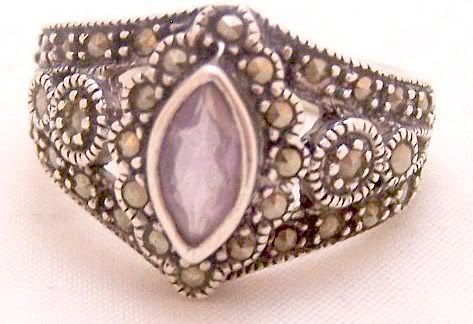Used for adornment since ancient times, Marcasite jewelry began to replace steel cut jewelry in the 18th century. Produced in large quantities by Germany, it became popular during war times, is most commonly placed on a sterling base, but can also be found on gold. Highly decorative, Marcasite jewelry lends to an very "vintage" look. When worn, this jewelry sparkles just like rhinestones, catching and reflecting the light in a very fashionable way.
When purchasing Marcasite jewelry, look for marks that hint at the grade of metal and/or maker, that there are no missing pieces (look at the pictures offered carefully, as missing Marcasites are often easy to miss), and that you are purchasing from a reputable seller.
Dating Marcasite jewelry can be difficult, as it's often only marked w/the grade of sterling or gold, or not marked at all. Generally speaking, if a piece is marked "Germany" its probably, c1930 +/- 10 years. If there is a copyright symbol, then the piece is most likely post-1955. If the piece is marked w/an artist's or maker's mark, you can date your piece by researching when that particular maker was working/in business.
Marcasite jewelry should be cleaned w/caution to avoid removing dark areas that are part of the design. Usually, a quick cleansing w/mild soap and water should do the trick, followed by drying the piece w/a soft cloth. Surface cleaning is the best; avoid submersing or dunking the piece.
Below are some examples of Marcasite Jewelry for your pleasure.

Courtesy of Lilly's Vintage Costume Jewelry

Courtesy of Eureka, I Found It!

Courtesy of Bitz of Glitz

Courtesy of Alison's Antiques & Vintage Jewelry

Courtesy of CranberryManor on Etsy
